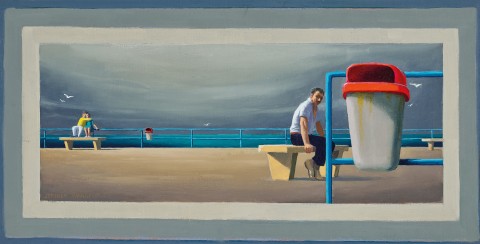STUDY FOR EVENING ON THE ESPLANADE, 1988
JEFFREY SMART
oil on canvas on composition board
25.0 x 48.0 cm
signed lower left: JEFFREY SMART
bears inscription on gallery label verso:
STUDY FOR EVENING ON / THE ESPLANADE, 1988
Australian Galleries, Melbourne (label attached verso)
Private collection, Melbourne, acquired from the above in 1989
Jeffrey Smart, Australian Galleries, Melbourne, 1 – 29 May 1989, cat. 15
McDonald, J., Jeffrey Smart. Paintings of the 70s and 80s, Craftsman House, Sydney, 1990, cat. 331, p. 162
Evening on the Esplanade, 1988 – 89, oil on canvas, 33.0 x 80.0 cm, private collection
Much has been written about the enigmatic qualities of Jeffrey Smart’s still and quasi-surreal paintings of suburban scenes. A Baudelairean painter of modern life, Smart painted a carefully geometrically constructed material world populated by anonymous figures engaged in puzzling and solitary activities. Although he spent the last forty years of his life living and working in Tuscany, Smart continued to paint from there the globally uniform imagery of post-war urban boom. It was the sculptural and semiotic qualities of these concrete and steel monuments that Smart admired and conveyed in most of his works. An intimate work, Study for Evening on the Esplanade, 1988 – 89 juxtaposes a contemplative solitary figure in the foreground with an amorous couple in the background, each personage seated on concrete benches on a built and fenced promenade along the seashore. Predictably, the skies above are glowering (although the time of day is only discernible from the title), and the brilliantly white silhouettes of seagulls proliferate. Jeffrey Smart’s freeze-framed scene on the esplanade is taut with emotive tension and suspended animation.
Although appearing to be faithful recordings of real-world places, Jeffrey Smart’s paintings are most often composite images, constructed from disparate elements recalled from real life locations or gleaned from other artworks (both his own and those painted by artists whom he admired). This complex weaving of motifs required a disciplined compositional sequence: starting with pencil studies, then (often several) oil studies and finally, a large-scale painting. The dialogue between these artworks is multifaceted, stretching across a lifetime of observations. This work is denoted as a study with the artist’s marker of painted borders, here a reinforcing sequence of white/French grey/ navy blue, all tones prevalent in the main composition. With a quality of completeness, it is no mere aide-memoire.
In comparison to the larger version, Evening on the Esplanade, 1988 – 89 (private collection) the study displays an interesting mirror image of the composition, and one in which the unspoken interaction between the three figures is reversed. Both versions feature one solitary man in the foreground and a man and woman, seated together; the two groups placed on opposing sides of the image. In this study, Smart encourages the viewer to enter the composition through the turned, beckoning head of the figure in the foreground. Staring blankly at the viewer, yet partially concealed by a fence railing and a rusting dustbin, the man seems to be either oblivious to the presence of the lovers perched precariously on the railing, or pointedly turning away from them. In the large version, however, the man gazes out towards the sea, while the woman, distanced from her partner, gazes wistfully towards him. Both arrangements suggest an intrigue, a complex web of unfulfilled desires and unrealised actions, adding to the dramatic possibility of Smart’s moody vista.
Scholar of modern art and author of Smart’s first monograph, Peter Quartermaine identified the source of his power as ‘from playing off what seems the everyday world depicted in real perspective against the adroitly concealed mechanics of the ‘abstract’ composition within the frame. This interplay lies at the heart of Smart’s work; it reaffirms the artist’s need to trade constantly with our everyday surroundings, and the pictures themselves celebrate an understanding of, and respect for, the world we inhabit’1
1. Quartermaine, P., ‘Jeffrey Smart’s Brave New World’, Art and Australia, Fine Arts Press, Sydney, vol. 23, no. 1, Spring 1985, p. 64
LUCIE REEVES-SMITH
